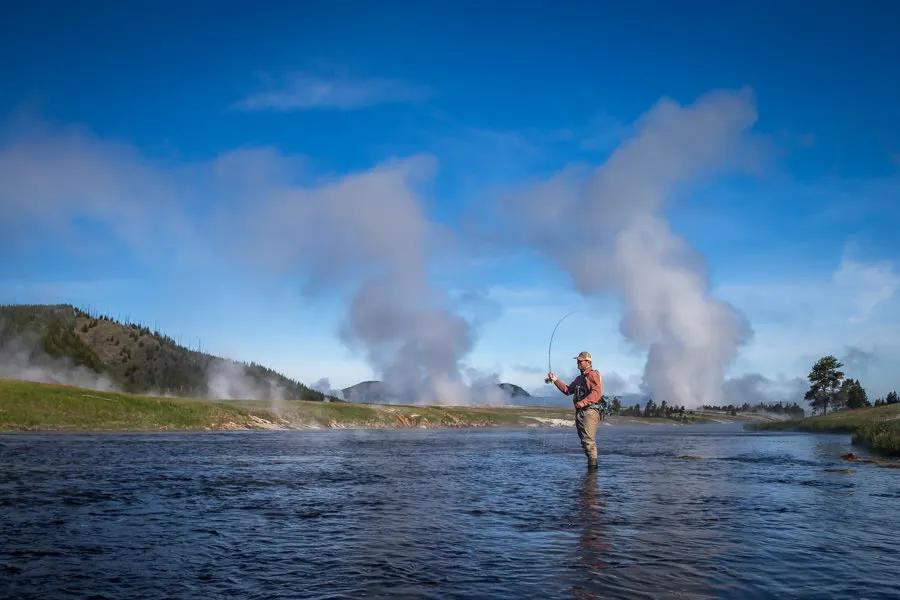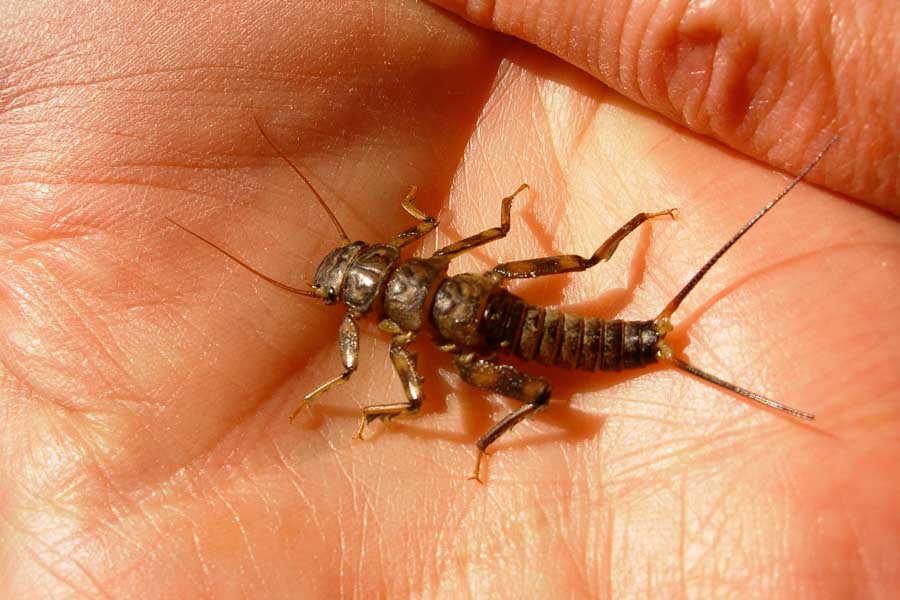
The fishing season in Yellowstone National Park begins at daybreak on the Saturday of Memorial Day weekend each year. For me, this is a special occasion viewed with much anticipation. The park was the site of my first fly fishing trip as a young kid. I spent my college summers working and living inside of Yellowstone. Presently, I am fortunate enough to guide visiting anglers in the park and share the knowledge that I have accumulated over the years. At 2.2 million acres, Yellowstone’s vast expanse contains an immense variety of fishing options. They do not, however, all fish well at the same times. Perhaps what I enjoy most about fishing in the park is the predictable seasonal shifts that occur each year. From swinging soft hackles on the Firehole in May to fishing Salmonflys on the Yellowstone in July to chasing big lake run fish in October, the fishing season flows along in a dynamic way.
Opening day falls during a transitional period of spring to summer here in the northern Rockies. The weather could be sunny and 65 degrees, or it could snow. It is not unheard of for each to happen in the same day. Runoff is typically in full swing in late May, but each year is different based on both the winter's snowpack and the day to day weather at the time. Although several of their parks fisheries are high and not worth fishing on the opening weekend, others are extremely productive and draw anglers from far and wide.

The Firehole River- An Opening Day Tradition
Along with being arguably the most unique trout river in the world, the Firehole River is by far the most consistent bet for good fishing on opening day in Yellowstone Park. As such, many anglers, local and visitors alike, make the trip to the Firehole for the opener each year. The Firehole doesn’t muddy like other rivers during runoff, instead becoming tea-colored and retaining plenty of visibility for fishing. During a really big water year, such as 2011, the Firehole may be slightly over its bank in spots, but still very fishable. The character of the river is mostly broad, gentle riffles and runs, so high water does not have a huge impact on the fish or your ability to get to them. Such a low gradient drainage also means that the water levels rise and fall slowly, a plus since fish thrive on consistency. Nez Perce Creek, the Firehole’s major tributary, tends to run dirtier and colder than the Firehole very early in the season, so fishing above this confluence can be a good idea. I like the water around Midway Geyser Basin, where thermal discharge warms the water and encourages insect activity.

The best way to catch fish on the Firehole on opening day is to swing soft hackles through the riffles and runs. This traditional wet fly swing is not in vogue these days for trout fishing, but this was the original method of presenting your fly in the British Isles way back in the 1600’s and it still works today. The swing presentation imitates an insect swimming towards the surface in preparation to hatch. To achieve this, the angler casts his line across the current, usually perpendicular to it or at a slight downstream angle. You then hold the line tight and follow with your rod tip low to the water as the current takes hold and your line sweeps across the river to get the “swing”. By starting at the top of a run and taking a step down after each cast, you are able to cover a large amount of water with this presentation. Since your fly is being drug by the current and you are holding a tight line, you will be able to feel the take, by far the most exciting aspect of the swing technique. When you feel the tug, don’t set the hook like you would when nymphing, simply raise the rod and let the fish hook itself. If you have never fished this style before, it is quite common to miss your first couple hits as you figure out the hookset. It is a feel technique, so once you figure it out your hookup rate will go way up. For flies, choose generic beadhead soft hackles, with a Pheasant Tail, Copper John, and Hare’s Ear being my top picks.

Depending on water conditions, there is a good chance to encounter some dry fly fishing on opening day as well. High water years will find opening day to be mainly a subsurface affair, but average water should yield a window of rising fish. Blue Winged Olives will be the most likely hatch, as the air and water temperatures will typically be too cold still for Caddis or Pale Morning Duns. Midges should not be overlooked early in the season, however. If a fish is refusing your Blue Winged Olive, it may be feeding on midges instead. While most of the fish in the Firehole are a bit on the small side and tend to be very aggressive feeders, there are a few real brutes that demand perfection on the anglers part. Make sure you have some adult BWO patterns, but you can often get by with a small parachute Adams or Purple Haze. I like to drop a BWO emerger about 12-14” behind my dry, and often find that I catch more trout on the emerger than the dry. I put floatant on my emerger so it rides in the surface film and I am able to see the fish take the fly. The most likely time to encounter a hatch will be late morning to early afternoon, so swing soft hackles until you see fish rising and then switch to the dries.

Gardner River: Wildcard Pick for Opening Day
While the Firehole is the top pick for opening day fishing because it fishes well each year, the lower stretch of the Gardner can be a sleeper bet for opening day some years. The water levels on the Gardner react quickly to the weather, so a few cool days and cold nights around opening day can bring the river into fishable shape. Water conditions on the Gardner early season are tied much more to the current temperatures than to overall snowpack, so it could fish even in a really high snow year if temperatures are cool. Additionally, a major thermal feature, the Boiling River, warms the lower 5 miles or so of river. While this is a detriment during the dog days of summer, this warm water increases the fishes metabolism early in the season and also stimulates insect activity.

If the river is in fact fishable, it will be strictly a nymphing game. Even in a best case scenario, the river will be high with 18” of visibility. Big and ugly style stonefly nymphs will be your best bet. I will typically fish two stoneflies and not bother with any smaller nymphs. Choose colors that contrast well with the water clarity, usually black or a black/brown or black/olive mix. You will want to present your flies tight to bank in the slower water around the edges, as the high water will have pressed the fish into these spots. The Gardner has many large boulders as well which create pockets of calm water for fish to hide. If you catch a trout, chances are that there are more in that same spot, so work it carefully. At high water, the fish are not spread out due to the limited amount of holding water available. I like to present my flies with a high-stick method, keeping as much line off the water as possible. With the high water, you can get close to the runs without fear of spooking the trout, so use this to your advantage to gain a better presentation. I will typically shorten my leader and add some split shot, allowing my flies to get into the strike zone quickly and avoiding drag by keeping them directly under the indicator. There is an old saying that goes, “The difference between a great nymph fisherman and a good one is one more split shot”, so add more weight if you are not bumping bottom occasionally.

While you can’t count on the Gardner for opening day every year, I would think twice about passing it up if it is fishable. Call local fly shops or check the hydrograph before you commit to heading out. If there has been several nights below freezing in a row and the hydrograph shows falling water, that is what you are looking for. While the Firehole is widely known as an early season fishery, the Gardner is not on the radar for most anglers until late June or early July. Thus, an opening day roll of the dice to head in this direction could lead to some solitude as well as good fishing.
Lakes
Lakes are another good option in Yellowstone Park on opening day. Stillwaters always have clear water and often the best time to fish some of the smaller lakes is early in the season before water temperatures get too warm. Trout Lake and Grebe Lake are notable options where anglers can often sight cast to trout and grayling. Trout lake is know for large but cutthroats between 14-22" and some larger rainbows that can run well over 20". Trout lake fish can be notoriously fussy so catch rates are low and expect some refusals. Grebe Lake holds a good population of small grayling along with some rainbows that get a bit larger. As with Trout Lake, Grebe Lake is best fished early in the season. For both lakes anglers can try dry flies during hatches or slow stripping smaller nymphs just below the surface. Sight casting is often more productive than blind fishing.
